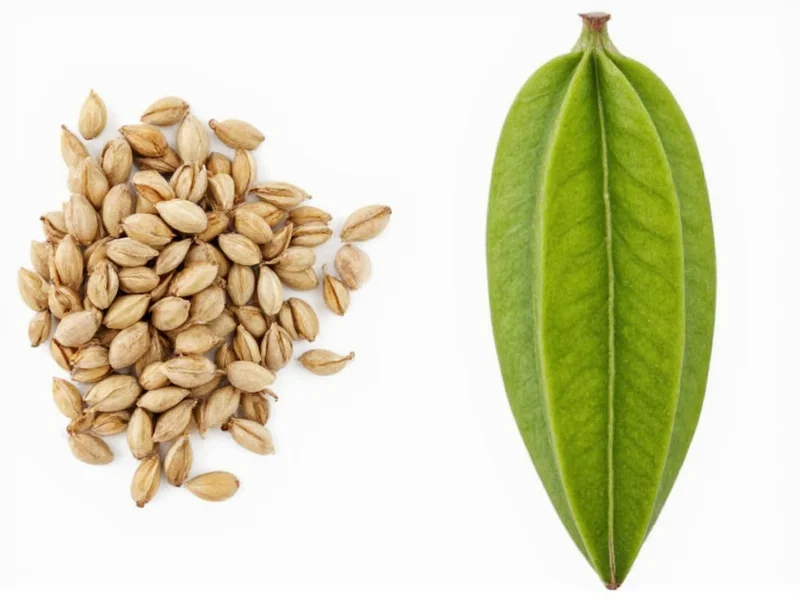Understanding the distinction between cardamom seeds versus pods is essential for maximizing flavor in your cooking. This aromatic spice, often called the “queen of spices,” appears in two primary forms that many home cooks mistakenly treat as interchangeable. Let's explore the practical differences that actually matter in your kitchen.
What Exactly Is Cardamom?
Cardamom (Elettaria cardamomum) originates from India and belongs to the ginger family. The most common varieties are green cardamom (smaller, more delicate flavor) and black cardamom (larger, smokier profile). Both types grow in distinctive triangular pods that contain the valuable seeds within.
Cardamom Pods: Structure and Characteristics
Cardamom pods consist of a thin, fibrous outer shell that protects the precious seeds inside. Green cardamom pods measure about 1 cm long, while black cardamom pods can reach up to 3 cm. The pods themselves contain minimal flavor compounds compared to the seeds, but they serve important culinary functions.
When using whole cardamom pods, chefs typically:
- Add them to rice dishes like biryani for subtle background flavor
- Infuse broths, stews, and braising liquids
- Include them in chai tea blends for gradual flavor release
- Remove them before serving since the fibrous texture is unpleasant to eat
Cardamom Seeds: Flavor Powerhouse
The tiny black seeds inside cardamom pods contain the highest concentration of essential oils that deliver cardamom's distinctive flavor. Each pod holds 8-16 seeds, which chefs access by gently crushing the pod with the back of a knife.
Chefs prefer using cardamom seeds when they need:
- Intense, immediate flavor in baked goods like Scandinavian pastries
- Precise control over spice distribution in spice blends
- Finely ground cardamom for coffee, desserts, or sauces
- Maximum aromatic impact in small-quantity recipes
| Characteristic | Cardamom Pods | Cardamom Seeds |
|---|---|---|
| Flavor intensity | Mild, subtle infusion | Strong, immediate impact |
| Best cooking method | Whole infusion in liquids | Crushed or ground |
| Shelf life | 6-12 months (whole) | 3-6 months (ground) |
| Texture consideration | Must be removed before serving | Can be consumed directly |
| Flavor profile | Floral, citrusy notes | Peppery, eucalyptus undertones |
Practical Cooking Applications
Understanding when to use cardamom seeds versus pods transforms your dishes from good to exceptional. Professional chefs follow these guidelines:
When to Use Whole Pods
Choose cardamom pods for long-cooking dishes where gradual flavor release matters. The whole pod acts like a flavor time-release capsule in:
- Rice dishes (remove before serving)
- Slow-cooked stews and braises
- Tea and coffee infusions
- Stocks and broths
When to Use Just the Seeds
Reach for cardamom seeds when you need immediate, concentrated flavor:
- Baking (cakes, cookies, breads)
- Dry spice rubs for meats
- Ground spice blends like garam masala
- Quick-cooking sauces and dressings
Substitution Guidelines
Running out of one form? Here's how to substitute cardamom seeds vs pods effectively:
- 1 whole pod = 8-10 seeds (approximately)
- 3 pods = 1/4 teaspoon ground cardamom
- Never substitute ground cardamom 1:1 for whole pods
- For best results, crush seeds just before use
Important note: Ground cardamom loses potency rapidly. When substituting ground cardamom for seeds or pods, use only 75% of the recommended amount since pre-ground spice has already lost some volatile compounds.
Storage Recommendations
Proper storage preserves cardamom's delicate flavor compounds:
For cardamom pods: Store whole pods in an airtight container away from light and heat. They maintain peak flavor for 6-12 months. Check freshness by squeezing a pod—it should release aromatic oils.
For cardamom seeds: Once removed from pods, seeds begin losing potency faster. Store in a dark glass container for 3-6 months. For extended storage, freeze seeds in an airtight container.
For ground cardamom: Use within 3 months for best results. Never store ground cardamom in clear containers as light accelerates flavor degradation.
Common Mistakes to Avoid
Even experienced cooks make these cardamom errors:
- Using whole pods in baked goods (creates unpleasant texture)
- Substituting ground cardamom 1:1 for whole pods
- Crushing seeds too far in advance of cooking
- Using old, stale cardamom that's lost its volatile oils
- Confusing green and black cardamom varieties in recipes
Professional chefs test cardamom freshness by biting a seed—fresh seeds should have a sharp, citrusy bite with slight numbing sensation. Stale cardamom tastes flat and dusty.
Maximizing Flavor in Your Dishes
For the most aromatic results with cardamom seeds versus pods:
- Toast whole pods lightly before use to enhance flavor
- Crush seeds with a mortar and pestle rather than a spice grinder
- Add whole pods early in cooking; add seeds near the end
- Combine both forms in complex dishes for layered flavor
- Pair cardamom with complementary spices like cinnamon and cloves











 浙公网安备
33010002000092号
浙公网安备
33010002000092号 浙B2-20120091-4
浙B2-20120091-4